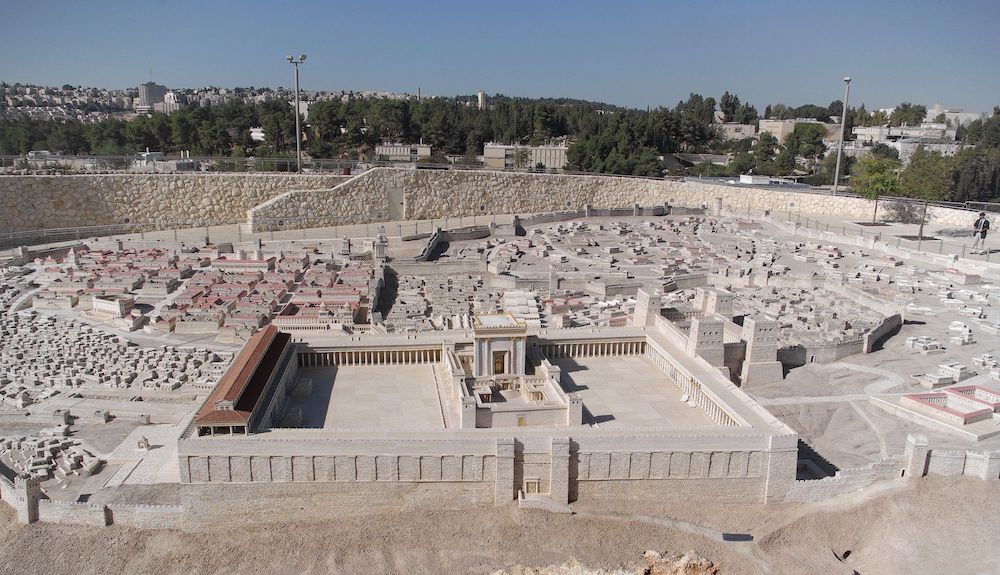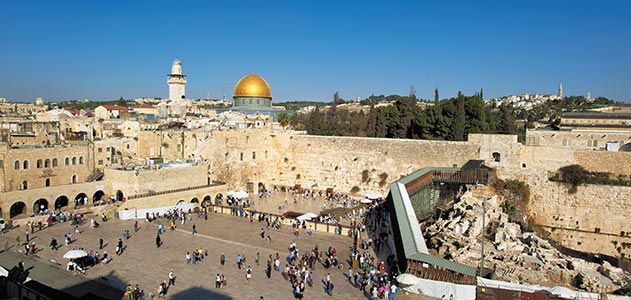Changing Worship Centers
The Old Testament period included three different sacred worship sites: The Tabernacle, the First Temple, and the Second Temple. I will briefly describe each here and elaborate below. The Jews built the Tabernacle after leaving Egypt and while still in the desert. That was around 1450 BC. They continued to use it until Solomon built the First Temple around 950 BC. That was destroyed by the Babylonians in 586 BC, and the Jews built the Second Temple around 519 BC.
The Tabernacle

The Jews built the Tabernacle (like a big tent) while in the desert after fleeing from the Egyptians. They built it because God told them to do so. The instructions of how to build it are located at the end of the book of Exodus. They used the Tabernacle from the time they were in the desert (1450 BC) until the time of King Solomon (950 BC). But, the Temple was not a place where all the Jews could worship together. (From the image above, you can see that it was not nearly big enough for all the Jews. Instead, the Jews came to the Tabernacle to sacrifice. A Jew could not simply sacrifice at his or her home. Instead, all sacrifices had to take place at the Tabernacle. Once they conquered the Promised Land, they placed the Tabernacle in the town of Shiloh. From the time of the conquest of the Promised Land to the time of King David, the Jews only had one place where they could offer sacrifices: the Tabernacle. For example, the prophet Samuel, who is described in I Samuel and was the prophet who installed Saul to be the first king, lived in Shiloh since that is where the Tabernacle was located. Even more: the Jews did not have any other place where they could gather together and worship other than the Tabernacle. So what did Jews do on the Sabbath at this time? They rested and remembered what God had done for them.
The different parts of the Tabernacle included the Ark of the Covenant, or just called the Ark. (This is awkward, since Noah also built an ark. But this Tabernacle ark was a small box). The Ark contained the 10 Commandments on the stone tablets, a golden jar of mannah, and Aaron's staff that had budded. (Hebrews 9:4; the story of Aaron's staff: Numbers 17) The Ark was in the middle of the Tabernacle, and then was placed in the Holy of Holies after the Temple was built.
The First Temple
King David wanted to build a Temple for God and so began moving the Ark to Jerusalem, but it only made it part of the way to Jerusalem. Around 950 BC, Solomon built the First Temple in Jerusalem. (Unfortunately, we do not know what happened to the Tabernacle.) The Ark was placed in the Holy of Holies located in the center of the Temple. Sacrifices were shifted from the Tabernacle to the Temple. The First Temple lasted for almost 400 years until the Babylonians defeated the southern kingdom of Judah and captured Jerusalem in 586 BC, when they also destroyed the Temple. The Babylonians then took most of the Jews to Babylonia (including Daniel). We do not know what happened to the Ark.
Synagogues
For about 70 years, and while they were in exile in Babylonia, the Jews did not have a Temple. That meant that they did not have a central worship center nor could they offer sacrifices to God as required by the Law of Moses. What were they to do? They could not build another Temple, because that had to be at the same place as the First Temple. Nevertheless, they still wanted to be able to gather together and worship God even if they could not rebuild the Temple and offer sacrifices. They developed what I like to call “Plan B.” “Plan B” is when the Jews, who lived in exile in Babylonia, decided to create an alternative place where they could worship since they did not have the Temple. A better phrase, though, would be “alternative places” because the Jews developed the idea of synagogues to replace the destroyed Temple. (“Synagogue” in Hebrew means “to gather together.”). Synagogues were like churches in that there are many of them. Plus, the synagogues were like the “churches” of the early Christian period when the Romans persecuted Christians: they met in each other’s homes. There is no evidence that the Jews built synagogues while they were living in exile in Babylonia from 586 BC to 519 BC. But the goal was achieved; the Jews met together so that they could continue to worship God even though the Temple had been destroyed and they could not sacrifice.
The Second Temple with Synagogues
Eventually, in 539 BC, Cyrus, the king of Persia, defeated the Babylonians and allowed the Jews to return home. You would think that the Jews would immediately rebuild the wall around Jerusalem so they could defend against being attacked again, but no. The first thing the Jews rebuilt was the Temple so that they could began offering sacrifices again. This is called the Second Temple and was completed around the year 519 BC. It lasted until the year AD 70, when it was destroyed by the Roman army. (King Herod greatly enlarged the Second Temple, and the retaining wall he had built around the Temple (to hold back dirt and enlarge the area around the Temple) is still visible today.)

To summarize: The importance of the Tabernacle and the two Temples was the same: that is where the Jews offered sacrifices. They could not offer sacrifices in their home villages or in their homes, but only in the Tabernacle and then Temple. This caused a problem after the year 586 BC when the First Temple was destroyed. Even though the Jews did develop an alternative place to worship, the synagogues, this was not a perfect replacement for a simple reason: the Jews could not offer their sacrifices in synagogues. Therefore, for the 70-year period between the destruction of the First Temple and the construction of the Second Temple, the Jews did not sacrifice. Once the Second Temple was built, the Jews immediately began to sacrifice again. Plus their stay in exile produced a bonus: the synagogues had worked so well as local places to worship (but not sacrifice) that Jews decided to continue to meet in synagogues after they built the Second Temple. That is why, for example, when Jesus was alive, he attended synagogues and visited the Temple. After the Second Temple was destroyed in the year AD 70, Jews continue to meet in synagogues, although they could not sacrifice there, and they have gathered in synagogues up to the present day. That is significant because it means that the Jews have not been able to sacrifice since the year AD 70!
Bonus Information
Nothing to do with the class, but fascinating nonetheless
Bonus information: This leads to the last point we will make in the section. Let me begin with a question: why is there so much turmoil and tension in the Middle East today? By understanding the temple, sacrifices, and the synagogues, you will better understand one answer to this question. Remember these two points: first, the Second Temple was destroyed in the year AD 70 and has not been rebuilt. Second, Jews can only sacrifice in the Temple and not in synagogues. When Israel became a nation in 1948, you would think the first thing they would want to build would be the Temple, and you would be right. After all, that is what happened when the returned from Babylonian captivity: they rebuilt the Temple before their own security, meaning the wall around Jerusalem. But they were not able to rebuild the Temple in 1948. Why? Because another building stands in the place where the Second Temple was located and where the Jews want to build the Third Temple. That building is the third most holy site in Islam and is known as the Dome of the Rock. (You can learn more about it online. We do not have the time to discuss it here.) Muslims will not allow the Dome of the Rock to be torn down so that the Jews can rebuild their Temple. Therefore, even though the Jews reestablished their nation in 1948, they have never not rebuilt the Temple. That is one reason why there is so much turmoil in the Middle East: the Jews want to rebuild the Temple, but they cannot because Muslims control the small piece of land in the middle of Jerusalem where the Temple once stood (an area about 37 acres).

© 2020-2021 Mark Nickens